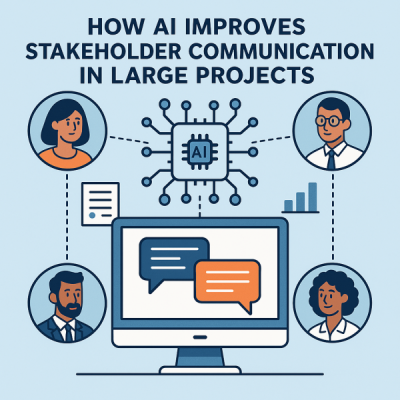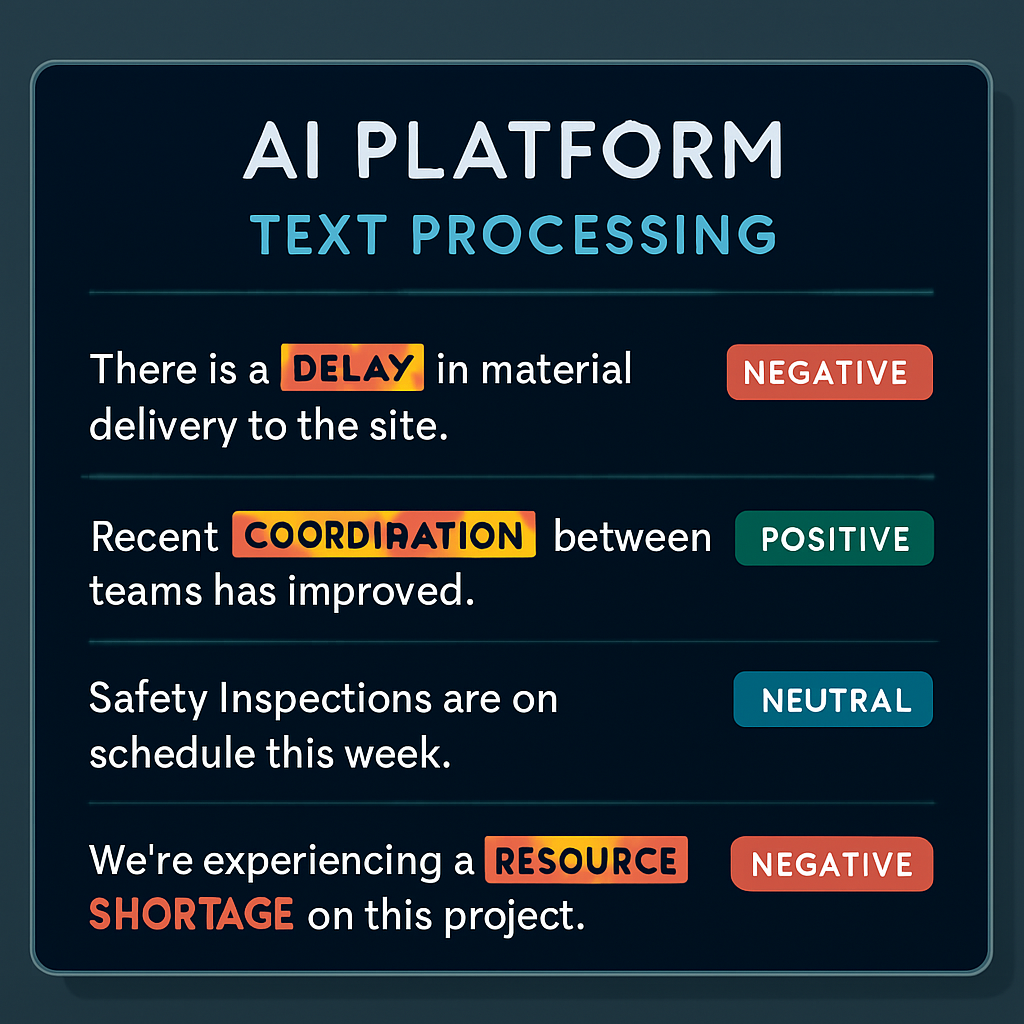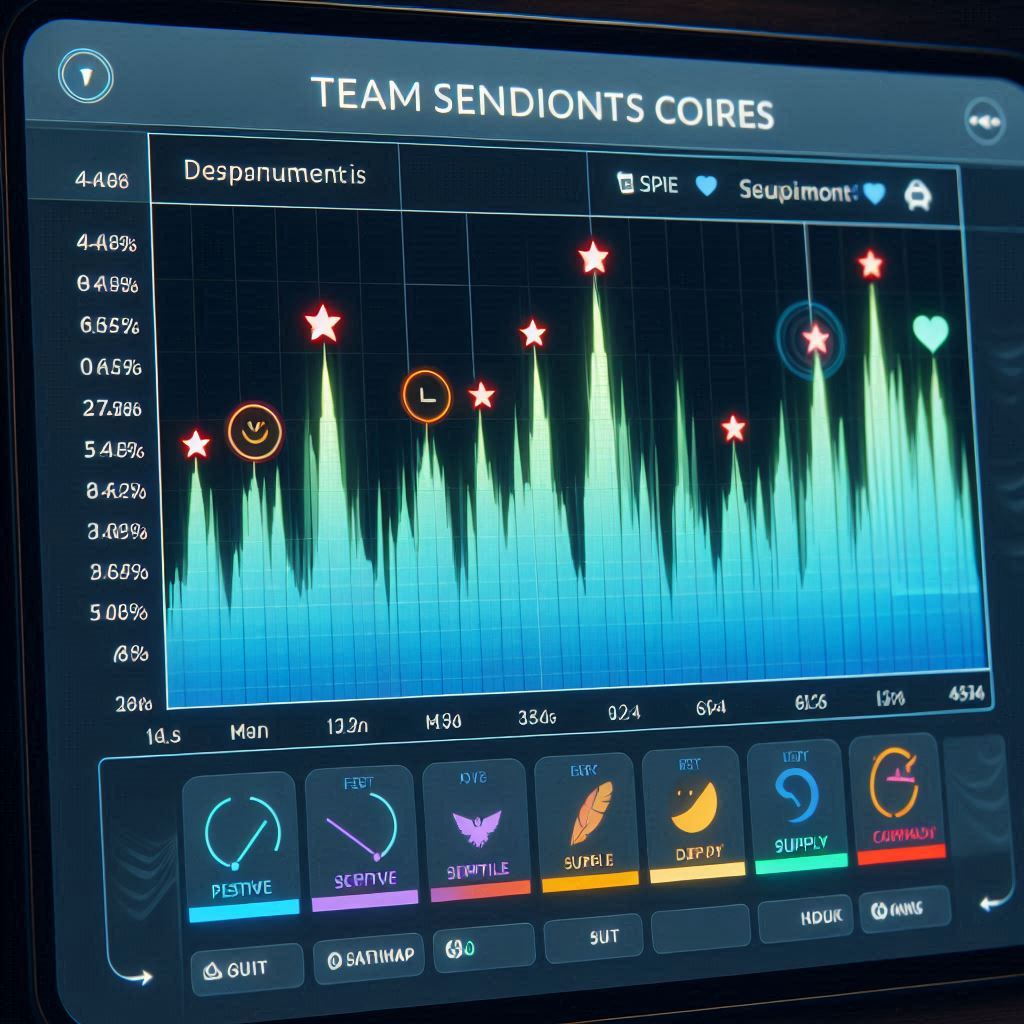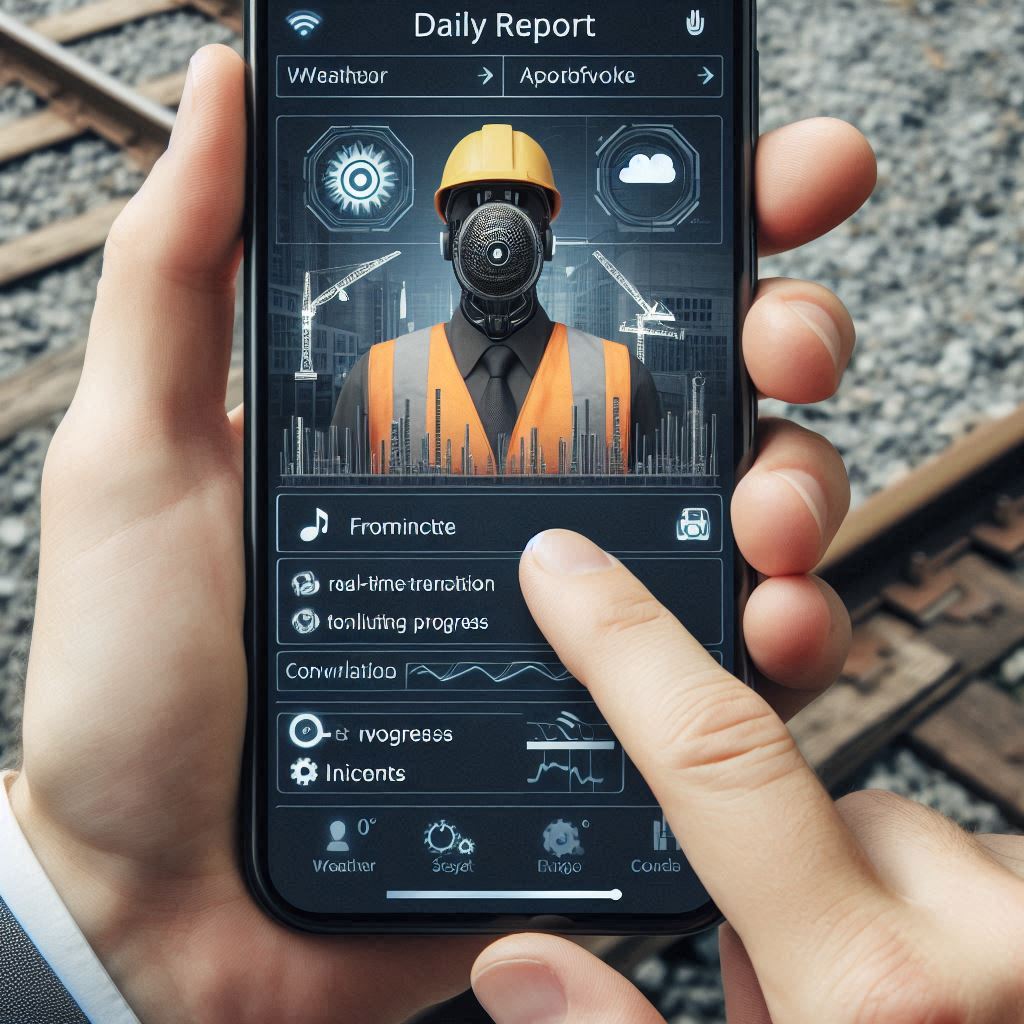
In large-scale architecture, engineering, and construction (AEC) projects, effective stakeholder communication is essential—but often difficult. With multiple parties involved, including developers, architects, engineers, contractors, regulators, and community representatives, keeping everyone informed, aligned, and engaged can be a monumental task.
Artificial intelligence (AI) is stepping in as a powerful tool to streamline, clarify, and enhance communication among stakeholders. From real-time data interpretation to automated reporting and natural language summarization, AI ensures that the right people receive the right information at the right time—without the noise.
In this article, we explore the many ways AI is transforming stakeholder communication in complex projects and why its use is becoming a strategic advantage in modern project management.
Large projects generate vast quantities of data—project updates, sensor readings, budgets, timelines, and more. AI tools can gather, process, and present this information in intuitive dashboards, making it easier for stakeholders to grasp what matters most.
Key capabilities:
Result:
Stakeholders get clearer, faster updates that focus on actionable insights, reducing misunderstandings and unnecessary meetings.
AI-driven chatbots can be deployed on project management platforms or communication tools to provide instant answers to common stakeholder questions.
Examples:
By handling routine queries 24/7, chatbots reduce the burden on human project managers and keep everyone more informed.
AI-powered sentiment analysis tools can scan communications—emails, meeting notes, and even survey responses—to gauge how stakeholders are feeling about project developments.
Use cases:
Benefit:
By understanding stakeholder sentiment proactively, project leaders can adjust communication approaches and mitigate potential issues early.
AI tools can now generate automated reports and meeting minutes using natural language processing (NLP) and speech-to-text technology.
How it works:
Impact:
Fewer things get lost in translation, and communication becomes consistent, fast, and traceable.
In international or public infrastructure projects, stakeholders may speak different languages or come from varying cultural contexts. AI-powered translation and language modeling tools help bridge these gaps.
Features:
Result:
Inclusive and accessible communication across global or diverse stakeholder groups.
Conclusion
AI is proving to be a vital enabler of efficient, transparent, and inclusive stakeholder communication in large projects. By automating routine reporting, personalizing insights, and interpreting feedback, AI ensures that everyone—from senior executives to community representatives—remains informed and aligned.
As projects become more complex and globally distributed, the ability to communicate clearly and intelligently becomes a competitive advantage. With AI in the communication loop, project leaders are better equipped to foster trust, improve outcomes, and deliver value across the board.

Post-project analysis is a critical yet often overlooked phase in the lifecycle of construction and engineering projects. After the last brick is laid and the ribbon is cut, organizations must take the time to evaluate what went well, what went wrong, and how future projects can benefit from the experience.
Traditionally, this process involves manual reviews of reports, meetings, and anecdotal feedback—an approach that is time-consuming and subject to human bias. However, Artificial Intelligence (AI) is transforming how companies conduct post-project reviews by automating data collection, identifying patterns, and generating actionable insights.
In this article, we explore how AI technologies are improving the lessons-learned process, enabling smarter, more efficient project delivery in the future.
Why Post-Project Analysis Matters
Every project—successful or not—offers valuable information. A robust post-project analysis helps organizations:
Yet, without a structured and data-driven approach, many valuable lessons remain untapped. This is where AI shines.
How AI Enhances Post-Project Analysis
Real-World Application
Imagine a construction firm analyzing a completed airport terminal project. AI reviews thousands of daily reports, finds that delays consistently occurred during HVAC installation, and links them to late material shipments. Meanwhile, sentiment analysis reveals low morale in the electrical team during peak load. This insight prompts the company to renegotiate supplier agreements and improve team communication processes for future projects.
Benefits of Using AI in Lessons Learned
Challenges and Considerations
Future Outlook
As AI tools become more sophisticated and integrated with Building Information Modeling (BIM) and project management platforms, post-project analysis will evolve into a near real-time, continuous learning system. In the future, insights from finished projects could be used dynamically to adjust live projects, closing the loop between learning and execution.
Conclusion
AI is revolutionizing the way we reflect on completed construction projects. By automating and enhancing the lessons-learned process, organizations can turn hindsight into foresight—ensuring that every project leaves a legacy of smarter decision-making. With AI as an ally, the end of a project is no longer just a finish line—it’s a launchpad for innovation.

Effective communication and collaboration are the backbones of any successful construction project. Yet, in complex, high-pressure environments where multiple stakeholders interact—contractors, engineers, architects, clients, and labor crews—misunderstandings, dissatisfaction, and misaligned expectations can easily derail progress.
This is where sentiment analysis, a branch of Natural Language Processing (NLP), steps in. By automatically analyzing the emotional tone and intent behind communications such as emails, meeting transcripts, field notes, and chat messages, sentiment analysis can identify emerging issues, boost morale, and improve overall team cohesion.
In this article, we explore how sentiment analysis is being used in construction project management to enhance team collaboration and ensure smooth project execution.
What is Sentiment Analysis?
Sentiment analysis is the computational process of detecting emotions, attitudes, and opinions in text-based data. It classifies text as positive, negative, or neutral, and can also detect specific emotions such as frustration, satisfaction, urgency, or confidence.
Using advanced machine learning algorithms and linguistic rules, sentiment analysis tools can process large volumes of unstructured communication to provide actionable insights into team dynamics.
How It Improves Team Collaboration
Key Use Cases in Construction
Real-World Example
A general contractor managing a large-scale infrastructure project used sentiment analysis to monitor daily logs and emails across multiple teams. The tool flagged an increase in negative sentiment from one subcontractor’s crew. On investigation, it was revealed that a delay in material delivery was affecting their schedule. Early detection helped the management team intervene, resolve the issue, and restore morale—without disrupting the critical path of the project.
Benefits of Sentiment Analysis in Collaboration
Challenges and Considerations
Best Practices for Implementation
Conclusion
In an industry where timelines are tight and teamwork is vital, understanding how people feel—before they even say it out loud—can be a game-changer. Sentiment analysis offers a subtle yet powerful way to promote collaboration, maintain morale, and catch warning signs before they spiral into bigger problems.
By embracing this technology, construction firms can not only build better structures but also stronger, more connected teams.

Project reporting is a cornerstone of construction management, critical for tracking progress, maintaining stakeholder communication, and ensuring accountability. However, generating these reports—whether daily field logs, weekly updates, or monthly executive summaries—can be time-consuming, repetitive, and prone to human error.
Enter Natural Language Processing (NLP), a subfield of artificial intelligence that enables machines to understand, interpret, and generate human language. By leveraging NLP, construction teams can automate the creation, summarization, and analysis of project reports, saving hours of manual labor while improving accuracy and consistency.
In this article, we’ll explore how NLP is transforming construction project reporting, what technologies are involved, and how your team can adopt these tools for smarter, faster documentation.
The Problem with Traditional Reporting
Manual project reporting involves:
This process not only eats into valuable time but also introduces the risk of inconsistent reporting, incomplete data, and subjective interpretation.
With construction projects growing more complex and data-rich, traditional reporting methods can’t keep up with the speed and scale of information required for modern decision-making.
How NLP Automates Project Reporting
Benefits of NLP-Driven Report Automation
Real-World Applications
Challenges and Considerations
How to Get Started
Conclusion
Natural Language Processing is revolutionizing how construction teams document and communicate. By automating report generation and turning unstructured text into actionable insights, NLP frees up valuable time, reduces risk, and brings new levels of clarity to project oversight.
As the construction industry continues to embrace digital transformation, NLP will become an essential tool—not only for streamlining workflows but also for enhancing collaboration and transparency across every stage of the project lifecycle.

Construction projects are inherently complex, involving numerous stakeholders, shifting timelines, evolving budgets, and unpredictable external factors. Despite thorough planning, delays remain one of the most common—and costly—challenges in the industry. Inaccurate forecasting can lead to budget overruns, missed milestones, and strained client relationships.
Machine Learning (ML), a form of artificial intelligence that excels at identifying patterns in large datasets, is now being used to anticipate project delays before they happen. By analyzing historical data, site conditions, scheduling dependencies, weather patterns, and workforce dynamics, ML helps project managers make proactive decisions that mitigate risk and improve on-time delivery.
In this article, we explore how ML is transforming delay prediction in construction and how your team can harness its power.
Why Traditional Delay Prediction Falls Short
Project managers have historically relied on Gantt charts, critical path analysis, and experience to assess schedule risks. While effective in stable environments, these methods often fall short in real-world construction settings where conditions are dynamic and interdependent.
Common limitations include:
Machine Learning overcomes these issues by continuously learning from diverse data sources and generating objective, data-driven predictions.
How Machine Learning Predicts Delays
Benefits of ML-Powered Delay Prediction
Real-World Applications
Challenges to Consider
Getting Started
Conclusion
Machine Learning empowers construction professionals with foresight once thought impossible. By predicting project delays early and accurately, teams can adjust plans, manage risk proactively, and protect project margins. As data becomes more accessible and algorithms more refined, predictive analytics will become a cornerstone of construction project management.
Embracing ML doesn’t just improve timelines—it builds a more intelligent, resilient, and competitive construction enterprise.

The Architecture, Engineering, and Construction (AEC) industry is embracing agile methodologies to enhance project management. Agile principles focus on flexibility, collaboration, and iterative development—qualities that align perfectly with the dynamic nature of AEC projects. The integration of Artificial Intelligence (AI) is amplifying the effectiveness of agile project management, driving efficiency, and enabling smarter decision-making.
AI-powered tools optimize project scheduling and resource management by analyzing historical data, project specifications, and current trends. These tools predict potential bottlenecks, ensuring resources—such as labor, materials, and equipment—are allocated efficiently.
For example, AI systems can recommend alternate schedules if weather conditions or supply chain issues are predicted to disrupt the original timeline.
AI solutions offer real-time insights into project progress through data collected from IoT devices, drones, and on-site sensors. This data enables project managers to track milestones, monitor resource usage, and ensure compliance with deadlines.
With machine learning algorithms, AI tools can identify deviations from planned workflows and suggest corrective actions, reducing delays and keeping the project on track.
Risk management is a cornerstone of agile project management, and AI excels at identifying and mitigating risks. By analyzing historical and real-time data, AI predicts potential issues—such as cost overruns, safety hazards, or quality concerns—before they escalate.
AI tools also provide actionable recommendations, enabling teams to address risks proactively.
Agile project management thrives on effective collaboration and communication, and AI enhances these aspects by streamlining information flow. AI-driven platforms provide centralized dashboards where stakeholders can share updates, track changes, and access real-time data.
Natural Language Processing (NLP) capabilities enable AI to summarize meetings, flag critical decisions, and send automated notifications, ensuring everyone stays aligned.
AI empowers project managers with data-driven insights, facilitating informed decision-making. Whether it’s choosing the most cost-effective materials or evaluating the impact of design changes, AI algorithms provide comprehensive analysis and simulations to support agile decision-making processes.
Repetitive tasks like updating schedules, generating reports, and tracking inventory are automated with AI, allowing project managers to focus on strategic activities. Automation reduces human error, saves time, and increases productivity.
AI tools are revolutionizing agile project management in the AEC industry by enhancing scheduling, risk management, collaboration, and decision-making. As these technologies evolve, they will further empower project managers to deliver complex projects on time, within budget, and to the highest quality standards.

Efficient project scheduling and resource allocation are critical for the success of any project, especially in complex industries like construction, engineering, and energy. Traditional methods often struggle with delays, cost overruns, and resource mismanagement. AI-powered tools are transforming project management by enabling smarter, faster, and more efficient planning and resource utilization.
AI-powered tools analyze historical data, project requirements, and real-time updates to create optimized schedules. These systems can:
For instance, machine learning models can identify patterns in past projects to forecast how long specific tasks will take and suggest adjustments to meet deadlines.
AI enhances resource allocation by ensuring the right resources are assigned to the right tasks at the right time. This includes:
By balancing resource availability with project needs, AI minimizes bottlenecks and improves productivity.
AI-driven systems monitor project progress in real time, using data from IoT devices, sensors, and project management software. These tools provide:
AI tools help project managers optimize costs by analyzing resource utilization and identifying inefficiencies. For example:
AI enables project managers to simulate multiple scenarios and assess the impact of different decisions on timelines and budgets. This helps in proactive risk management by preparing contingency plans for potential issues.
AI-powered platforms streamline communication by providing a centralized hub where team members can access real-time updates, share data, and collaborate effectively. Natural Language Processing (NLP) capabilities summarize key information, ensuring stakeholders stay aligned.
AI-powered project scheduling and resource allocation are revolutionizing project management by improving efficiency, reducing costs, and enhancing collaboration. As AI technologies evolve, they will continue to drive smarter decision-making, enabling projects to be delivered on time, within budget, and to the highest standards.

Managing contracts and resolving claims are critical yet complex tasks in industries like construction, engineering, and energy. The traditional methods of handling these processes often involve manual reviews, lengthy negotiations, and potential disputes. Artificial Intelligence (AI) is revolutionizing contract and claims management by improving efficiency, accuracy, and decision-making.
AI-powered tools automate the drafting and review of contracts, significantly reducing the time and effort involved. By analyzing contract templates and legal documents, AI can:
Natural Language Processing (NLP) enables AI to understand legal language and provide actionable insights, reducing errors and improving contract quality.
AI systems analyze historical contracts and claims data to identify potential risks in new agreements. These tools flag clauses that may lead to disputes or financial exposure, enabling proactive risk mitigation.
For instance, AI can detect vague or contradictory language that could cause confusion, ensuring contracts are clear and enforceable.
AI improves the efficiency of claims management by automating tasks like:
By processing large volumes of data, AI ensures faster resolution of claims, reducing delays and minimizing conflicts.
AI uses predictive analytics to foresee potential claims based on project performance, contract compliance, and historical patterns. This enables organizations to address issues early, avoiding costly disputes and legal battles.
AI-powered platforms facilitate collaboration by providing a centralized space for all stakeholders to review contracts, track changes, and resolve disputes. AI can also simulate negotiation scenarios, suggesting strategies that achieve favorable outcomes.
AI ensures that contracts and claims comply with industry standards and regulations. Automated audit trails track all changes and actions, ensuring accountability and transparency throughout the process.
AI is transforming contract and claims management by streamlining processes, reducing risks, and improving accuracy. As these technologies advance, they will continue to enhance efficiency, reduce costs, and foster trust in complex contractual environments.

In today’s fast-paced and interconnected world, managing risks in complex projects is a daunting challenge. From supply chain disruptions and regulatory compliance to technical failures, project managers face a myriad of uncertainties that can jeopardize timelines and budgets. This is where artificial intelligence (AI) steps in, offering innovative tools to identify, analyze, and mitigate risks more effectively than ever before.
AI leverages advanced technologies like machine learning (ML), natural language processing (NLP), and predictive analytics to provide comprehensive risk management solutions. Here are some key areas where AI is making a difference:
The future of risk management lies in the integration of AI with advanced technologies like blockchain, IoT, and digital twins. These combinations will enable:
AI-driven risk management is revolutionizing how complex projects are planned and executed. By identifying potential risks early, providing actionable insights, and enabling data-driven decisions, AI enhances project resilience and success rates. However, to fully leverage these benefits, organizations must address challenges like data quality and skill gaps.
As AI technology continues to advance, its role in risk management will only grow, helping project managers navigate uncertainties with confidence and precision.